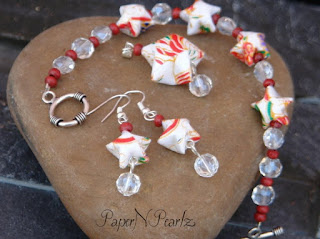In the past couple of years, I have made and sold quite a few of my origami earrings online. This has been a fairly easy job for me, since I could make the earrings I wanted and put them up for sale when I wanted to. There was no pressure and it helped me make more and more complex earrings.
This year, for the first time, I got a couple of opportunities to be a part of local market places that sold hand crafted goods. Since I have never been a part of such craft bazaars before, these experiences have been real eye openers!
Let me start off with the many lessons that I learnt during these forays: One - I could not gradually make earrings at my own pace! I needed enough earrings to at least cover the 2 tables that each stall would be provided with. And let me tell you, paper jewelry does NOT occupy space! So in the first event, even though I had about 200 pairs of earrings (Whew! Making them was an immense challenge! It felt like I was spending whole weeks at my work table..), my table looked half full! By the way, my earrings included leaf earrings, star earrings, umbrellas, pine cones, butterflies and hearts.

Two - So since my first stall looked hardly full, I decided that I need to diversify my jewelry. It was not sufficient that I made earrings, I needed to make things that take up space. So I started making bracelets and chains/necklaces. And that is what went into my second stall. I had a bigger variety of earrings - I included rose stud earrings, bird stud earrings, woven earrings, modular and wreath earrings. My bracelets included butterfly bracelets, star bracelets and bird bracelets. But still, I found that my tables did not look filled in!
Three - For my third event, I diversified even more! I included handmade bags, pillow boxes and little Christmas ornaments. And finally I was happy with the way my stall looked :)
Four - For a marketplace, it is not sufficient that you have just your products. In addition, a lot of accessories are needed. A major item was the packaging stuff. I needed boxes/zip lock packs to keep the jewelry in. Then I needed bags to put the boxes in. These bags also had to be handmade bags, to go with the handmade theme. I also found that having a stand listing the price of all the items was very useful. And a sign board was an absolute essential.
Now, these are things that I need not worry about in a online shop and they were all additional expenses! So now I absolutely need to participate in more events just to recuperate all that money that I have invested! :)
Five - A few of the buyers were not able to appreciate handmade works. To them, all I was using was paper. So they believed that I should be selling it for a 10th of the price I quoted. But thankfully, this was a minority. For the most part, people understood the effort that goes into handmade.
Among the positives, the biggest positive was the opportunity to meet a lot of handcraft enthusiasts who had put up stalls in the events. I was amazed at the creativity that I saw. Jewelry, clothes, greeting cards, paper bags, paintings, clay art, terra cotta jewelry, crocheted works - an absolutely mind-boggling array of talents were on display!
Two - I found a lot of people fascinated by paper jewelry! For a lot of them, this was the first time they were seeing something like that. In fact, a lot of them were not aware that my jewelry was made from paper. The moment I said that it was paper jewelry, they did a double take and immediately fingered the jewelry to check that it was in fact paper!
Then they had the usual questions on durability, water resistance etc.
Three - Children were fascinated with the birds and stars. Young adults loved the butterflies. And those in their 30s were very appreciative of my rose studs. All of them were very appreciative of the effort. Quite a few of them were aware of origami and a few even knew that tiny roses were very difficult to fold. So they were all the more fascinated by the jewelry.
So these events have been learning, yet delightful experiences. I have made new crafter friends, I have got a list of people who want to learn origami, I have new clients who want specific jewelry in specific colours.
While I will continue with my online sale (it is hassle-free as compared to a bazaar!), I would love to participate in yet another event and exhibit more of my jewelry. Though, not any time soon!











































